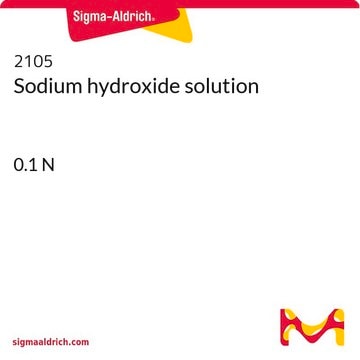1.09956
Idrossido di sodio
c(NaOH) = 1 mol/l (1 N), concentrate for preparing 1000 mL volumetric solution for titration, Titrisol®®
About This Item
Prodotti consigliati
product name
Idrossido di sodio, for 1000 ml, c(NaOH) = 1 mol/l (1 N) Titrisol®
Tensione di vapore
3 mmHg ( 37 °C)
Livello qualitativo
Nome Commerciale
Titrisol®
Forma fisica
liquid
Impiego in reazioni chimiche
reaction type: Acid-base reactions
Concentrazione
1 M
tecniche
titration: suitable
pH
14 (20 °C in H2O)
Densità
1.030 g/cm3 at 20 °C
Temperatura di conservazione
15-25°C
Stringa SMILE
[OH-].[Na+]
InChI
1S/Na.H2O/h;1H2/q+1;/p-1
HEMHJVSKTPXQMS-UHFFFAOYSA-M
Cerchi prodotti simili? Visita Guida al confronto tra prodotti
Applicazioni
- Adsorption Studies: Sodium hydroxide solution is used in treating polymer adsorbents to enhance their adsorption properties. A recent study investigated the effect of treating a PVC/Aliquat-336 polymer adsorbent with sodium hydroxide on chromium (VI) adsorption. The treatment improved the adsorption capacity of the polymer, making it more effective in removing heavy metals from aqueous solutions (Ouazine et al., International Journal of Environmental Analytical Chemistry, 2022).
- Synthesis of Sodium Ethoxide: Sodium hydroxide solution is employed in the synthesis of sodium ethoxide, an important reagent in organic synthesis. Research has demonstrated that sodium ethoxide can be synthesized efficiently at ambient temperature using sodium hydroxide and ethanol-90. This method offers a straightforward and cost-effective approach for preparing this key chemical intermediate (Randriana et al., World Journal of Applied Chemistry, 2021).
- Corrosion Inhibition: Sodium hydroxide solution is used in corrosion inhibition studies. Research has shown that an aqueous extract of Thespesia populnea plant leaves can effectively inhibit the corrosion of aluminum steel in sodium hydroxide solution. The study utilized electrochemical techniques to demonstrate the formation of a protective film on the steel surface, highlighting the potential of natural inhibitors in industrial applications (Brindha and Venkatraman, Research Journal of Chemistry and Environment, 2023).
Note legali
Avvertenze
Danger
Indicazioni di pericolo
Classi di pericolo
Eye Dam. 1 - Met. Corr. 1 - Skin Corr. 1A
Codice della classe di stoccaggio
8B - Non-combustible, corrosive hazardous materials
Classe di pericolosità dell'acqua (WGK)
WGK 1
Punto d’infiammabilità (°F)
Not applicable
Punto d’infiammabilità (°C)
Not applicable
Certificati d'analisi (COA)
Cerca il Certificati d'analisi (COA) digitando il numero di lotto/batch corrispondente. I numeri di lotto o di batch sono stampati sull'etichetta dei prodotti dopo la parola ‘Lotto’ o ‘Batch’.
Possiedi già questo prodotto?
I documenti relativi ai prodotti acquistati recentemente sono disponibili nell’Archivio dei documenti.
I clienti hanno visto anche
Il team dei nostri ricercatori vanta grande esperienza in tutte le aree della ricerca quali Life Science, scienza dei materiali, sintesi chimica, cromatografia, discipline analitiche, ecc..
Contatta l'Assistenza Tecnica.





